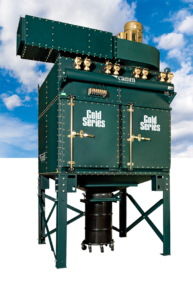A Canadian aerospace company considered retrofitting its dust collectors that were used for removing combustible dust generated during high-velocity oxygen fuel (HVOF) coating, blasting and grinding applications. The plan was to upgrade five old units to meet NFPA standards during a four-week shutdown. However, Camfil Air Pollution Control regional manager Wayne Zimmer suggested that purchasing new dust collectors would be a better option. Camfil APC does not retrofit dust collectors due to the hidden dangers and costs involved: Zimmer and his team recommended one of Camfil APC’s new dust collectors to help the manufacturer meet NFPA compliance. These new units offered a faster and more straightforward installation, eliminating potential problems and delays associated with retrofitting older collectors. After evaluating the pros and cons, the client decided to switch to Camfil. The dust collection systems, installed three years ago with filter cartridges, have operated without any issues or need of replacement filters. The customer now plans to replace the rest of its old dust collectors with NFPA-compliant systems. To get the full story, watch Camfil APC’s Wayne Zimmer in this video. Combustible dust poses significant fire and explosion risks for many manufacturers. It is generated during manufacturing and packaging processes using combustible materials. Sources of combustible dust include: The HVOF spraying, blasting and grinding processes used at the above-mentioned aerospace company are prime examples of activities that produce combustible dust. When airborne, these particles can ignite and explode upon contact with an ignition source, such as friction, static electricity or an open flame. Such events can lead to equipment damage, facility destruction, workplace injuries and even fatalities. According to DustEx Research Ltd., between January 1 and July 1, 2023, there were 159 fires, 32 explosions, 71 injuries and 48 fatalities related to combustible dust worldwide. Historical data from the United States shows an average of 28.4 combustible dust explosions per year, resulting in 28 injuries and 3.5 fatalities between 2016 and 2023. Implementing preventative strategies has helped reduce these incidents. These strategies include robust dust collection systems designed to capture combustible dust and equipped with explosion protection equipment. Choosing the right dust collector depends on the types of dust generated at your facility. An accredited testing lab can determine if dust is combustible and to what extent. These labs recognize standards set by NFPA, ASTM or other relevant industry bodies. Consistent testing methodologies should be used to ensure repeatable and comparable results. The Kst value serves as a benchmark for classifying the explosiveness of a dust cloud. For example, magnesium with a Kst value of 508 is extremely explosive, while charcoal with a Kst of 10 is not explosive. The Kst value also helps determine the design of an appropriate explosion protection system for a dust collection system. Not any dust collection system will do when it comes to filtering and containing combustible dust. Without the right filters and explosion protection system, a dust collector can be the source of an explosion because it contains a significant amount of explosive dust in a confined area. Contact our dust collection experts to assess your needs and recommend the most effective dust collection system to mitigate combustible dust and keep your facility safe. Click here to find out more about our products and why so many companies are choosing to partner with Camfil to design and build their total dust collection systems. AGV rack is a new type of automated rack, composed of an AGV car and a traditional rack. It is part of modern intelligent warehouses. Through AGV unmanned transport vehicles, automated transportation and sorting functions within the warehouse can be achieved, achieving high automation in the entire process of warehousing, loading and unloading, handling, stacking, picking, packaging, distribution, and shipping, thereby improving logistics turnover efficiency, ensuring the timeliness and accuracy of logistics supply, and achieving flexible warehousing functions. AGV rack is a low-cost automated Storage Rack, which has the characteristics of simple structure, low price, convenient use, good quality, and quick effectiveness. Reduce and eliminate unnecessary steps in the production process, reduce unnecessary job settings, and ensure traceability of product quality. Improved the efficiency of goods storage and classification. AGV shelves solve the five major problems of traditional shelves: sorting, displacement, secondary sorting, re inspection of packaging, and sorting according to flow direction. In traditional shelf warehouses, the circulation of goods is usually done manually, with a huge workload, and AGV shelves precisely solve this problem. AGV Rack,Metro Shelving,Storage Shelves,Movable Storage Shelves Suzhou Aomeijia Metalic Products Co,Ltd. , https://www.amjshelf.com
Watch the Full Switching Story
Dangers of Combustible Dust
Is your dust combustible?
Which dust collector?
 Camfil’s Gold Series industrial dust collectors safely remove all types of toxic and combustible dusts and fumes from an environment. With an explosion protection system that exceeds NFPA and ATEX standards, it protects workers from both occupational exposure and combustible dust explosions. Click here to watch a short video about this collector.
Camfil’s Gold Series industrial dust collectors safely remove all types of toxic and combustible dusts and fumes from an environment. With an explosion protection system that exceeds NFPA and ATEX standards, it protects workers from both occupational exposure and combustible dust explosions. Click here to watch a short video about this collector.
The benefits of applying AGV shelves: improving productivity: allowing managers to concentrate labor resources on value-added tasks and products, while repetitive tasks are handled by AGV; Reduce product damage: The installed sensors and load protection devices allow AGV to accurately and safely handle all loads; Reduce labor costs: By replacing employees with AGVs, fewer employees can be used for operations; Improve efficiency: Seamless integration with production, ERP, and WMS software, enabling accurate on time material flow; Improving safety: The AGV car is equipped with sensors for obstacle detection, which can predict road conditions, avoid obstacles, and ensure the safety of goods.